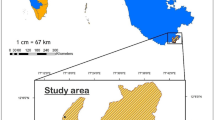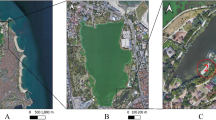Abstract
We describe population structure, mobility and habitat preferences of the butterfly Lycaena helle using a survey of the populations in the Westerwald area (Western Germany) and mark-recapture techniques. Three out of 83 recorded populations were intensively studied in 1995. In all, 1596 individuals (537 females) were uniquely marked. The average adult residence time was 8 days, the maximum 34 days. L. helle is extremely sedentary. Average distances between first and subsequent captures were 37 and 61 meters for males and females respectively. Population-specific differences are interpreted as being caused by the influence of barriers and corridors. The potential for colonization is regarded as poor, and isolated populations seem to be under a higher risk of extinction than other ones. Preferred habitats were abandoned moist meadows with rich aspects of Polygonum bistorta on sheltered, warm, and humid stands. Owing to the destruction of natural habitats (moorland) L. helle now colonizes almost exclusively anthropogenic ephemeral habitats (abandoned moist meadows) in Central Europe. This results in serious conservation problems, as the biology of the species does not seem to be adapted to a high turn-over rate of habitats.
Similar content being viewed by others
References
Bernardi, G. and De Lesse, H. (1952) La variabilité géographique de Lycaena helle Denis et Schiff. (Lep. Lycaenidae). Rev. Franc. Lépidopt. 13/14, 203–214.
Brunzel, S. (1996) Populations ökologische Untersuchung am Schwalbenschwanz (Papilio machaon L. 1758). Z. Ökologie u. Naturschutz 5, 37–46.
Brunzel, S. and Reich, M. (1996) Zur Metapopulationsstruktur des Roten Scheckenfalters (Melitaea didyma Esper 1779) auf der Schwäbischen Alb. Z. Ökologie u. Naturschutz 5, 243–253.
Cordero, C.R. and Soberón, J. (1990) Non-resource based territoriality in males of the butterfly Xamia xami (Lepidoptera: Lycaenidae). J. Ins. Behav. 3, 719–732.
Dennis, R.L.H. and Bardell, P. (1996) The impact of extreme weather events on local populations of Hipparchia semele (L.) (Nymphalidae) and Plebejus argus (L.) (Lycaenidae): hindsight, inference and lost opportunities. Entomologist's Gaz. 47, 211–225.
Dennis, R.L.H. and Eales, T. (1997) Patch occupancy in Coenonympha tullia (Müller, 1764) (Lepidoptera: Satyrinae): habitat quality matters as much as patch size and isolation. J. Insect Conserv. 1, 167–176.
Dennis, R.L.H. and Shreeve, T.G. (1997): Diversity of butter-fly species on British islands: ecological influences underlying the roles of area, isolation and faunal source. Biol. J. Linn. Soc. 60, 257–275.
Dover, J.W., Sparks, T.H. and Greatorex-Davies, J.N. (1997) The importance of shelter for butterflies in open landscapes. J. Insect Conserv. 1, 89–97.
Ellenberg, H., Weber, H.E., Düll, R., Wirth, V., Werner, W. and Paulissen, D. (1992) Zeigerwerte von Pflanzen in Mitteleuropa, 2. edition. Scripta Geobotanica 18, 1–258.
Elligsen, H., Beinlich, B. and Plachter, H. (1997) Effects of large scale cattle grazing on populations of Coenonympha glycerion and Lasiommata megera (Lepidoptera: Satyridae). J. Insect Conserv. 1, 13–23.
Hannemann, J. (1928) Etwas über Chrysophanus amphidamas Esp. Int. Entomol. Zeitschrift 22, 209–210.
Hanski, I., Kuussaari, M. and Nieminen, M. (1994) Metapopulation and migration in the butterfly Melitaea cinxia. Ecology 75 (3), 747–762.
Hanski, I., Pakkala, T., Kuussaari, M. and Lei, G. (1995) Metapopulation persistence of an endangered butterfly in a fragmented landscape. Oikos 72, 21–28.
Hasselbach, W. (1985) Lycaena helle - die Zucht einer in der Bundesrepublik Deutschland vom Aussterben bedrohten Art (Lep.: Lycaenidae). Entomol. Zeitschrift 95, 70–76.
Hill, J.K., Thomas, C.D. and Lewis, O.T. (1996) Effects of habitat patch size and isolation on dispersal by Hesperia comma butterflies: implications for metapopulation structure. J. Anim. Ecol. 65, 725–735.
Kockelke, K., Hermann, G., Kaule, G., Verhaagh, M. and Settele, J. (1994) Zur Autökologie und Verbreitung des Kreuzenzian-Ameisenbläulings, Maculinea rebeli. Carolinea 52, 93–109.
Meineke, J.U. (1982) Einige Aspekte des Moor-Biotopschutzes für Großschmetterlinge am Beispiel moorbewohnender Großschmetterlingsarten in Südwestdeutschland. Telma 12, 85–98.
Meyer, M. (1980) Die Verbreitung von Lycaena helle in der Bundesrepublik Deutschland (Lep.: Lycaenidae). Entomol. Zeitschrift 90, 217–224.
Meyer, M. (1982a) Révision systématique, chorologique et écologique de Lycaena helle Denis & Schiffermüller, 1775 (Lycaenidae). Linneana Belgica 8, 238–260, 345-358, 451-466.
Meyer, M. (1982b) Les races européennes de Lycaena helle Denis & Schiffermüller, 1775, et leurs biotopes (Lepidoptera, Lycaenidae). Proc. 3rd Congr. Europ. Lepid., Cambridge 1982, 125–137.
Meyer, M. and Helminger, T. (1994) Untersuchungen zu einer Population von Lycaena helle arduinnae Meyer, 1980 im nordwestlichen Ösling (Lepidoptera, Lycaenidae). Bull. Soc. Nat. Luxemb. 95, 315–326.
Mühlenberg, M. (1989) Freilandökologie. Heidelberg, Wiesbaden: Quelle & Meyer.
Munguira, M.L., Martin, J. and Balletto, E. (1993) Conservation biology of Lycaenidae: A European overview. In Conservation biology of Lycaenidae (butterflies) (T.R. New, ed.), pp. 23–34. Oxford: Information Press.
Lewis, O.T., Thomas, C.D., Hill, J.K., Brookes, M.I., Crane, T.P.R., Graneau, Y.A., Mallet, J.L.B. and Rose, O.C. (1997) Three ways of assessing metapopulation structure in the butterfly Plebejus argus. Ecol. Entomol. 22, 283–293.
Pauler, R., Kaule, G., Verhaagh, M. and Settele, J. (1995) Untersuchung zur Autökologie des Schwarzgefleckten Ameisenbläulings, Maculinea arion (Linnaeus 1758) (Lepidoptera: Lycaenidae), in Südwestdeutschland. Nachr. entomol. Verein Apollo, N.F. 16, 147–186.
Plachter, H. (1995) Functional criteria for the assessment of cultural landscapes. In Cultural landscapes of universal value (Von Droste, B., Plachter, H. and Rössler, M., eds.), pp. 393–404. Jena: G. Fischer.
Plachter, H. (1996) Central European approach for the protection of biodiversity. In Nature conservation outside protected areas (D. Ogrin, ed.), pp. 91–108. Conf. Proc. Ministry of Environment and Physical Planning, Ljubljana.
Pretscher, P. (1984) Rote Liste der Großschmetterlinge. In Rote Liste der gef¨ahrdeten Tiere und Pflanzen in der Bundesrepublik Deutschland (Blab, J., Nowak, E., Trautmann, W. and Sukopp, H., eds.), 4th edition. Greven: Kilda.
Pullin, A.S. (ed., 1995) Ecology and conservation of butterflies. London: Chapman & Hall.
Pullin, A.S. (1997) Habitat requirements of Lycaena dispar batavus and implications for re-establishment in England. J. Insect Conserv. 1, 177–185.
Réal, P. (1962a) Les Pyrénées Orientales, refuge entomologique. Ann. sci. Univ. Besancon, 2e sér. Zool. 17, 97–110.
Réal, P. (1962b) Les stations de Lycaena helle D. et Schiff. dans le Doubs. Note de faunistique jurassienne no 1. Ann. sci. Univ. Besançon, 2e sér. Zool. 17, 111–118.
Réal, P. (1962c) Quelques remarques sur Lycaena helle D. et Schiff. dans les Monts de la Madeleine. Ann. sci. Univ. Besançon, 2e sér. Zool. 17, 119–120.
Réal, P. (1962d) Lycaena helle D. et Schiff. (ex Heodes amphidamas Esp.) dans le Massif de Sancy. Ann. sci. Univ. Besançon, 2e sér. Zool. 17, 121–134.
Rutowski, R.L. (1991) The evolution of male mate-location behaviour in butterflies. Amer. Naturalist 138, 1121–1139.
Sabel, K.-J. and Fischer, E. (1992) Boden-und vegetationsgeographische Untersuchungen im Westerwald. Frankfurter geowiss. Arbeiten, D 7, 1–268.
SBN (Schweizerischer Bund für Naturschutz, ed.) (1987) Tagfalter und ihre Lebensräume. Arten-Gefährdung-Schutz. - 2nd edition. Basel: SBN.
Schurian, K.G. and Fiedler, K. (1996) Adult behaviour and early stages of Lycaena ochimus (Herrich-Schäfer [1851]) (Lepidoptera: Lycaenidae). Nachr. entomol. Verein Apollo, N.F. 16, 329–343.
Scott, J.A. (1974) Population biology and adult behaviour of Lycaena arota (Lycaenidae). J. Lepid. Society 28, 64–75.
Scott, J.A. and Opler, P.A. (1975) Population biology and adult behavior of Lycaena xanthoides (Lycaenidae). J. Lepid. Society 29, 63–66.
Settele, J., Henle, K. and Bender, C. (1996) Metapopulationen und Biotopverbund: Theorie und Praxis am Beispiel von Schmetterlingen und Reptilien. Z. Ökologie u. Naturschutz: 5, 187–206.
Settele, J., Margules, C., Poschlod, P. and Henle, K. (eds., 1996) Species dispersal in fragmented landscapes. Dordrecht, Kluwer.
Shreeve, T.G. (1992) Adult behaviour. In The ecology of butter-flies in Britain (R.L.H. Dennis, ed.), pp. 22 ff. Oxford: University Press.
Southwood, T.R.E. (1976) Ecological methods, 2nd edition. London, New York: Chapman and Hall.
Thomas, C.D. and Harrison, S. (1992) Spatial dynamics of a patchily distributed butterfly species. J. Animal Ecol. 61, 437–446.
Thomas, C.D., Thomas, J.A. and Warren, M.S. (1992) Distributions of occupied and vacant butterfly habitats in fragmented landscapes. Oecologia 92, 563–567.
Väisänen, R., Kuussaari, M. Nieminen, M. and Somerma, P. (1994) Biology and conservation of Pseudophilotes baton in Finland (Lepidoptera, Lycaenidae). Ann. Zool. Fennici 31, 145–156.
Watt, W.B., Chew, F.S., Snyder, C.R.G., Watt, A.G. and Rothschild, D.E. (1977) Population structure of pierid butterflies I. Numbers and movements of some Colias species. Oecologia 27, 1–22.
Weidemann, H.J. (1995) Tagfalter beobachten, bestimmen, 2nd edition. Augsburg: Naturbuch.
Author information
Authors and Affiliations
Rights and permissions
About this article
Cite this article
Fischer, K., Beinlich, B. & Plachter, H. Population Structure, Mobility and Habitat Preferences of the Violet Copper Lycaena Helle (Lepidoptera: Lycaenidae) in Western Germany: Implications for Conservation. Journal of Insect Conservation 3, 43–52 (1999). https://doi.org/10.1023/A:1009630506216
Issue Date:
DOI: https://doi.org/10.1023/A:1009630506216




